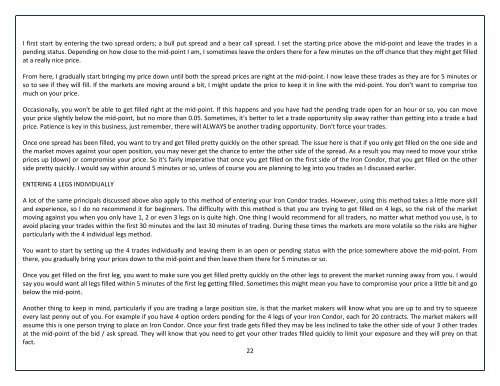Bullshit Free Guide to Iron Condors - Options trading IQ
Bullshit Free Guide to Iron Condors - Options trading IQ
Bullshit Free Guide to Iron Condors - Options trading IQ
You also want an ePaper? Increase the reach of your titles
YUMPU automatically turns print PDFs into web optimized ePapers that Google loves.
I first start by entering the two spread orders; a bull put spread and a bear call spread. I set the starting price above the mid‐point and leave the trades in a<br />
pending status. Depending on how close <strong>to</strong> the mid‐point I am, I sometimes leave the orders there for a few minutes on the off chance that they might get filled<br />
at a really nice price.<br />
From here, I gradually start bringing my price down until both the spread prices are right at the mid‐point. I now leave these trades as they are for 5 minutes or<br />
so <strong>to</strong> see if they will fill. If the markets are moving around a bit, I might update the price <strong>to</strong> keep it in line with the mid‐point. You don't want <strong>to</strong> comprise <strong>to</strong>o<br />
much on your price.<br />
Occasionally, you won't be able <strong>to</strong> get filled right at the mid‐point. If this happens and you have had the pending trade open for an hour or so, you can move<br />
your price slightly below the mid‐point, but no more than 0.05. Sometimes, it's better <strong>to</strong> let a trade opportunity slip away rather than getting in<strong>to</strong> a trade a bad<br />
price. Patience is key in this business, just remember, there will ALWAYS be another <strong>trading</strong> opportunity. Don't force your trades.<br />
Once one spread has been filled, you want <strong>to</strong> try and get filled pretty quickly on the other spread. The issue here is that if you only get filled on the one side and<br />
the market moves against your open position, you may never get the chance <strong>to</strong> enter the other side of the spread. As a result you may need <strong>to</strong> move your strike<br />
prices up (down) or compromise your price. So it's fairly imperative that once you get filled on the first side of the <strong>Iron</strong> Condor, that you get filled on the other<br />
side pretty quickly. I would say within around 5 minutes or so, unless of course you are planning <strong>to</strong> leg in<strong>to</strong> you trades as I discussed earlier.<br />
ENTERING 4 LEGS INDIVIDUALLY<br />
A lot of the same principals discussed above also apply <strong>to</strong> this method of entering your <strong>Iron</strong> Condor trades. However, using this method takes a little more skill<br />
and experience, so I do no recommend it for beginners. The difficulty with this method is that you are trying <strong>to</strong> get filled on 4 legs, so the risk of the market<br />
moving against you when you only have 1, 2 or even 3 legs on is quite high. One thing I would recommend for all traders, no matter what method you use, is <strong>to</strong><br />
avoid placing your trades within the first 30 minutes and the last 30 minutes of <strong>trading</strong>. During these times the markets are more volatile so the risks are higher<br />
particularly with the 4 individual legs method.<br />
You want <strong>to</strong> start by setting up the 4 trades individually and leaving them in an open or pending status with the price somewhere above the mid‐point. From<br />
there, you gradually bring your prices down <strong>to</strong> the mid‐point and then leave them there for 5 minutes or so.<br />
Once you get filled on the first leg, you want <strong>to</strong> make sure you get filled pretty quickly on the other legs <strong>to</strong> prevent the market running away from you. I would<br />
say you would want all legs filled within 5 minutes of the first leg getting filled. Sometimes this might mean you have <strong>to</strong> compromise your price a little bit and go<br />
below the mid‐point.<br />
Another thing <strong>to</strong> keep in mind, particularly if you are <strong>trading</strong> a large position size, is that the market makers will know what you are up <strong>to</strong> and try <strong>to</strong> squeeze<br />
every last penny out of you. For example if you have 4 option orders pending for the 4 legs of your <strong>Iron</strong> Condor, each for 20 contracts. The market makers will<br />
assume this is one person trying <strong>to</strong> place an <strong>Iron</strong> Condor. Once your first trade gets filled they may be less inclined <strong>to</strong> take the other side of your 3 other trades<br />
at the mid‐point of the bid / ask spread. They will know that you need <strong>to</strong> get your other trades filled quickly <strong>to</strong> limit your exposure and they will prey on that<br />
fact.<br />
22


